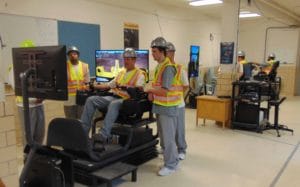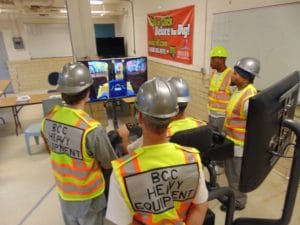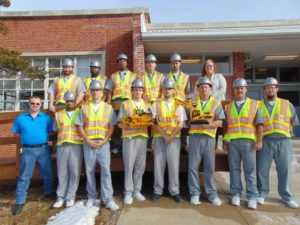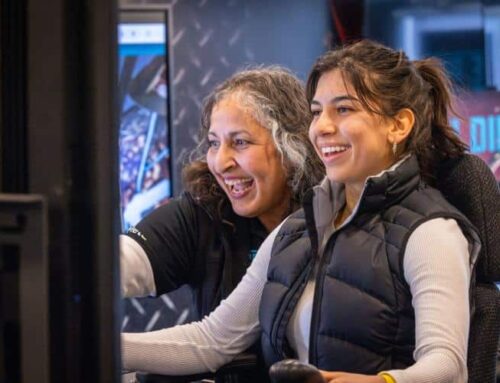Changing lives is not just an aspiration for David Hope, it’s his daily hands-on work. As a vocational teacher with the Missouri Department of Corrections, Hope gives offenders the training and confidence they need to have a real opportunity for success after release.
Reducing Recidivism
The Missouri DOC is working hard to reduce recidivism through job skills and training, and programs such as the Heavy Equipment Operators (HEO) class have the added benefit of helping to meet employers’ demand for skilled labor. It took the work of several people to put together a program that gives offenders a second chance in life and helps meet the demand for a qualified workforce. That demand fuels partnerships with employment specialists and business owners.
The Boonville program began to take shape in summer 2016, after Nate Hurn, Cat® Simulators Account Manager, met with Matt Sturm and Joan Reinkemeyer, then director and assistant director of the DOC’s Division of Offender Rehabilitative Services. The Missouri Department of Economic Development’s Division of Workforce Development helped the DOC to purchase the Cat Simulators through grant funding. The DOC then launched a program that changes the way skilled trades are taught to offenders.
Developing a Skilled Workforce
Hope grew up around farm machinery and heavy equipment, so when the opportunity arose to pass along his knowledge to offenders, he jumped at the chance. After six years as a corrections officer, he turned in his blue uniform, took a vocational teacher position and immediately set about developing the program’s curriculum and entry criteria. He wants to not only train offenders on heavy equipment operation but also teach them the skills they need to become first-class employees. Each offender-student, selected through an application process, has a high school diploma or equivalency certificate, a record of good behavior, and a release date scheduled within the next five years. They’ll leave the institution ready for the workforce — and far less likely to return to prison.
Each class is 12 weeks long, with approximately 360 hours of instruction and training for 15 students at a time. Students earn apprenticeship hours from the United States Department of Labor (USDOL) as well as training in Mine Safety and Health Administration (MSHA) 46 and Occupational Safety and Health Administration (OSHA) 10 which prepare them to pass these certification exams upon release. Hope continues to refine the program to make the students more knowledgeable and marketable. For example, he’s adding information on reading grade stakes and GPS grade programs to his existing curriculum.
Hands-on Learning
Hope takes the “Crawl, Walk, Run” approach practiced in the military. He begins by teaching safety and making sure the class understands personal protection equipment (PPE), and then introduces students to tools such as grease guns. Basic Cat-based eLearning materials familiarize students with the machines.
“For obvious reasons, the offenders cannot use actual equipment,” says David Hope regarding his work environment, the basement of a building on a former boys’ school campus constructed in 1889. Stationed amid safety-reminder posters and whiteboards scrawled with training notes are three Cat Simulators, each operated by a student in a hard hat, a reflective vest and gray prison uniform. Since 1983 the campus has functioned as Boonville Correctional Center, and since 2017 the classroom has been home to a HEO class, the latest of 34 career and tech programs offered by the Missouri Department of Corrections. “Learning hands-on is really important with heavy machinery,” Hope says, “and the simulators provide that opportunity.” Students learn to do a virtual machine walk-around through the simulator and then learn to identify the parts.
Actual machine parts supplement the simulators. Pieces of track, cutting edges, teeth, hydraulic hoses, belts, rods, cylinders, air blowers and rollers are arranged across a long table in the classroom. Hope shows the students what to look for during a machine inspection. “I tell them, if you catch problems during the inspection, you don’t have prolonged downtime,” he says. “That’s important to employers.” He would like to explore the possibility of making inoperable machines available for the offenders to practice their real-time walk-arounds.
Learning the machine controls on the simulator, as well as all of the machine-specific applications and tasks included in the simulators, makes up a large part of the class. Cat Simulators’ companion training materials — including videos, images, task methodology, and safety and maintenance manuals — inform the theoretical part of machine training. With three simulators and 15 people, Hope figured out a rotation that works to give everyone plenty of time for training. He’s learned that students do better in small groups with personal instruction from a trainer. Rotating within groups gives everyone a chance to learn the Excavator, Dozer and Wheel Loader operations.
Tracking Success
The simulators are equipped with a records management program to track student progress. The system comes with benchmarks provided by Cat expert operators but can be changed to ease or challenge each user level.
Hope sets criteria for certain performance goals, such as not riding the brakes, keeping the bucket low when maneuvering and avoiding collisions. He took an average of all student outcomes to create his own benchmarks for classes and set expectations for the students, who are excelling. “Some students ended up doing even better than the Cat® experts!” he boasts. Finally, Hope set up different tests for students, beginning with wide timeframes and narrowing them down by the end of the 12 weeks to test for criteria such as gear use, bucket use and task form.
Hope says that in addition to learning marketable skills, the offenders are learning soft skills, such as critical thinking, problem solving and teamwork. “They help each other identify parts on the walk-around and encourage each other during the simulation practice,” he says. He is molding offenders into potential employees after their release dates, with meaningful skills to offer an employer.
A Positive Future
When Hope graduated his first class, instead of the traditional cap and gown, the graduates opted to wear their safety vests and hard hats with the tassels on top for the graduation ceremony.
The program is catching on. Hope now has four classes planned per year and a year-long waiting list to get into the class. Offenders at other facilities who are interested in the Boonville program can apply and request a transfer. The department continues to work on grant options to help fund the heavy equipment operator program, as well as other career and technical education programs, to add more simulators and enable more offenders to train for a future. Hope would like to add another simulator, which will increase both the class size and hands-on training time. The new generation Cat Simulators allow for converting from one model to another by changing out the controls, so he could add training for two more machines. He has his eye on a Motor Grader simulator because such machines are “hard to operate, and every county in the nation has one,” as well as an Articulated Truck, which teaches how to operate a vehicle with an oscillating hitch to load and unload materials.
While training provides opportunity and hope, jobs are the true measure of program success. Hope invites local companies and unions to visit and talk to students about the industry and the job market. The DOC Reentry Office also coordinates personal and video interviews. One member of Hope’s first graduating class completed a video interview with a local employer, landed a job immediately, and started work as soon as he was released.

The Heavy Equipment Operators program at Booneville Correctional Center, Mo., has a year-long waiting list.
“Some people will have a job when they walk out the gates,” Hope says. That’s the best-case scenario for the offender, for public safety and for Missouri employers who are looking for skilled workers and having a hard time finding people with the right qualifications. “Go to any jobsite and you’ll see empty trucks,” says Hope. “There are companies who cannot even bid on work because they don’t have enough skilled labor. We’re teaching valuable skills that will benefit the offenders and the state’s employers, and reduce recidivism rates.









